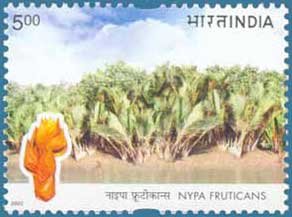Mangrove Palm (Nypa fruticans)

Technical Data
| Stamp Set | UN Conference on Climate Change, New Delhi |
|---|---|
| Date of Issue | October 30, 2002 |
| Denomination | Rs. 5 |
| Quantity | 3,000,000 |
| Perforation | Syncopated 13 x 13¼ |
| Printer | Calcutta Security Printers Ltd |
| Watermark | No Watermark |
| Colors | Multicolor |
| Catalog Codes |
Michel IN 1925 Stamp Number IN 1976 Yvert et Tellier IN 1690 Stanley Gibbons IN 2091 WADP Numbering System - WNS IN036.02 |
| Themes | Conferences | Flowers | Palm-trees | Plants (Flora) | Rivers | Trees | U.N.O. |
Table of Contents
Mangrove Palm (Nypa fruticans)
Overview
- Scientific Name: Nypa fruticans
- Common Name: Mangrove Palm
- Family: Arecaceae (Palm Family)
Description
- Appearance: Nypa fruticans is a unique palm that grows in dense clumps along mangrove swamps and tidal riverbanks. It is notable for its large, feathery leaves and its distinctive growth habit.
- Leaves: The leaves are pinnate (feather-like) and can reach lengths of up to 3 meters (10 feet). They have a rich green color and are arranged in a rosette at the top of the trunk.
- Flowers: The flowers are unisexual and small, with the male flowers forming dense spikes. The female flowers are found in clusters and develop into fruits.
- Fruits: The fruit is a large, globular cluster known as a “palm heart” or “Nipa fruit,” which contains multiple seeds surrounded by a fibrous husk. The fruit’s outer shell is covered in a layer of hard, spiky scales.
Habitat
- Distribution: Nypa fruticans is found in tropical regions of Southeast Asia, including the Philippines, Malaysia, Indonesia, and northern Australia. In India, it is located in the mangrove forests of the Andaman and Nicobar Islands.
- Environment: It thrives in brackish water and is often found in tidal zones, river deltas, and mangrove swamps. It is adapted to the fluctuating water levels and saline conditions typical of mangrove environments.
Ecological Importance
- Coastal Protection: The dense stands of Nypa fruticans help stabilize coastal sediments and reduce erosion. They act as a buffer against storm surges and flooding.
- Habitat: The palm provides habitat and food for various wildlife, including birds, insects, and aquatic creatures. It is an important part of the mangrove ecosystem’s biodiversity.
- Nutrient Cycling: The decay of fallen leaves and fruits contributes organic matter to the mangrove ecosystem, aiding in nutrient cycling and supporting the overall health of the coastal environment.
Conservation Status
- Threats: Nypa fruticans faces threats from habitat destruction, land reclamation, and pollution. These activities can lead to the loss of mangrove ecosystems and reduce biodiversity.
- Conservation Efforts: Efforts to conserve Nypa fruticans include protecting mangrove areas from deforestation, promoting sustainable land use practices, and supporting mangrove reforestation projects.
Cultural and Economic Value
- Traditional Uses: The leaves of Nypa fruticans are used in traditional crafts and as roofing material. The fruit and seeds are used in local cuisine and for medicinal purposes. The palm heart, found in the fruit, is considered a delicacy in some regions.
- Economic Value: Nypa fruticans provides resources for local communities and contributes to the livelihoods of people living in coastal areas.
Stamp Design
The stamp featuring Nypa fruticans highlights the distinctive appearance of the Mangrove Palm, focusing on its large, feathery leaves and fruiting structure. The design emphasizes the ecological significance of the species in mangrove ecosystems and aims to raise awareness about the importance of protecting these vital habitats.
